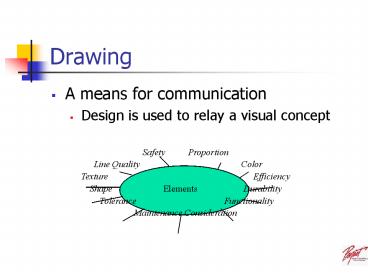Drawing - PowerPoint PPT Presentation
1 / 10
Title: Drawing
1
Drawing
- A means for communication
- Design is used to relay a visual concept
Safety Proportion Line
Quality
Color Texture
Efficiency Shape
Durability
Tolerance
Functionality
Maintenance Consideration
Elements
2
Prior to the Industrial Revolution
- Cave men
- Scratched symbols and scenes on cave walls
providing us with a record of life and skills
known during the Stone Age - The Oudea fortress
- The first known floor plan of buildings to be
constructed in an orderly fashion - Objects were handmade one at a time
3
Fabricating Techniques 4000BC-1800AD
Forming Processes
Hammering, Stamping, Casting
Joining Processes
Soldering, Riveting, Forge Welding, and Gluing
Example of an early cast piece
4
Industrial Revolution
- Parts were made in batches (1850)
- Mass production (1900)
- Need for interchanging parts
- Measuring tools were developed
- Profits
- Efficient use of time and materials
- Replacement parts were desired
5
Fabricating Techniques 1800AD-1900AD
Forming Processes
Electroplating, Steel Rolling
Tools
Shaping, Milling
Example of milling
6
Fabricating Techniques 1900AD-1920AD
Forming Processes
Tube Rolling, Hot Extrusion
Tools
Geared Lathes, Hobbing,
High Speed, and Carbide Tools
Example of a geared lathe
7
Fabricating Techniques 1920AD-1970AD
Forming Processes
Powdered Metals, Electroforming, and
Explosive Forming
Tools
Numerical Control, Electrical and Chemical
Machining, and Synthetic Diamond
Example of a CNC part
8
Fabricating Techniques 1970AD-2000AD
Forming Processes
Plastic Forming, Computer-Aided Design and
Manufacturing, and Rapid Prototyping
Tools
Coated Tools, Water Jet Machines, Electrical
Discharge, Industrial Robots, Programmable Logic
Controls, and Unattended Factories
Example of Stereolithography
9
Current Drafting and Design Tools
10
Manufacturing Techniques

